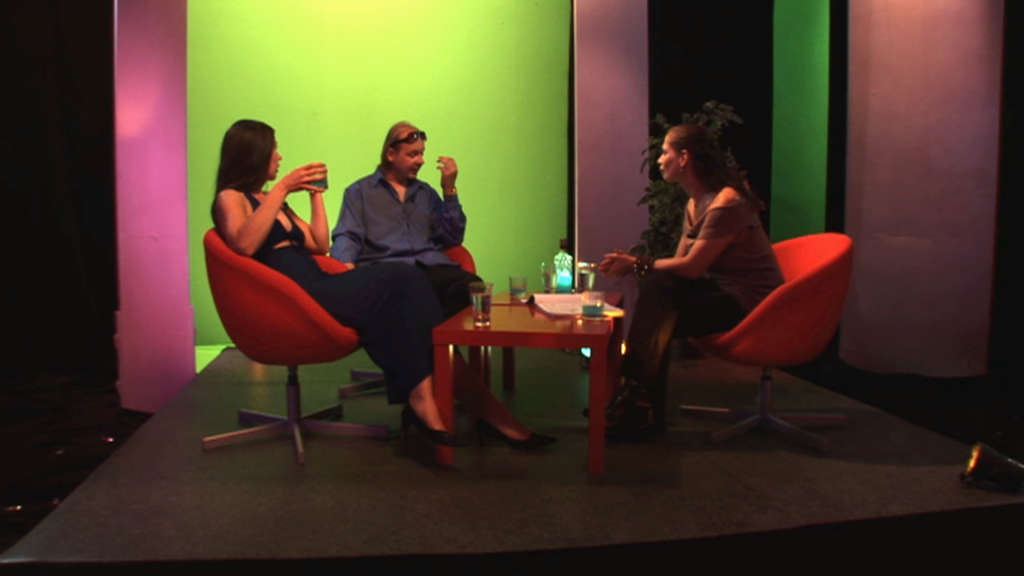Television Broadcasting
Television broadcasting has had a similarly formative influence on the audiovisual works of visual artists as classical cinema. Artists participate in the creation of television programmes or criticise them, establish their own independent studios or transform popular shows in their pieces. The medium of television itself becomes the subject of artworks and performances, such as in the event Větev – Prorážení televize větví [Branch – Perforating a Television with a Branch], during which artists Petr Váša and Marian Palla installed a ripped off branch into an operating television set.
A satirical approach is also at the core of Zurich by the director Adéla Babanová, which draws on the conventions of the television talk show. The staged discussion sees a fictional host, the artist, and a curator discussing their deceased friend, the artist Eva Weber. Attempts at critically assessing Weber’s work, however, fail because of the self-centred comments of all the participants of the debate. The director used the format of the televised debate for a satirical exploration of the principles and behaviour that are typical of both the worlds of popular entertainment and high art.
The work of artist Zdeněk Mezihorák is an example of revisiting snippets of television broadcasting. In his trilogy of videos: Po stopách krve [On the Trail of Blood], Spejbl a Hurvínek [Spejbl and Hurvínek], and 13. revír [Guard 13], he selected fragments from a recording of the Czech Television broadcasting and arranged them in short loops that reflect the character of the films.
Marian Palla, Petr Váša: Větev – Prorážení televize větví [Branch – Perforating a Television with a Branch]
11 min., 1994
Show in database
This event recording by Petr Váša and Marian Palla was created during the time they worked together at the Intermedia Studio at the Faculty of Arts of the Brno University of Technology. With Větev, the two teachers-artists – with a striking measure of irony – described the tension between the use of new media and live action. In the film, they get up from their desks and use a drill to install a branch into a television receiver in operation. We can recognise the original broadcast on the screen: horse racing, a children’s animated film, a rock concert. The quality of the image and sound of the documentation is intentionally low and complemented by subtitles: “Prorážení televize větví” [Perforating a Television with a Branch] and “Litujeme zdroje electronického obrazu zraňované a trpící přírodou” [We are sorry for sources of electronic images damaged by and suffering from nature.]. The documentation was made by the artist Jennifer de Felice.
Zdeněk Mezihorák: Po stopách krve [On the Trail of Blood]
2 min., 1998
Show in database
Zdeněk Mezihorák: 13. revír [Guard 13]
1.5 min., 1998
Show in database
Zdeněk Mezihorák: Spejbl a Hurvínek [Spejbl and Hurvínek]
1.5 min., 1998
Show in database
The trilogy of videos Po stopách krve [On the Trail of Blood], Spejbl a Hurvínek [Spejbl and Hurvínek], and 13. revír [Guard 13] represents an authorial revision of snippets of television broadcasting. To this aim, Mezihorák recorded an entire day of the broadcasting of the first channel of Czech Television in 1998 onto a Hi8 cassette. He later searched for short fragments in this recording that bear traces of various forms of media damage, or instead capture seemingly empty or unidentifiable scenes. He then arranged these into short loops that reflect equally the mise-en-scène of the original films and the characters of their media surface. Although the work seems to be of a digital nature, it was made using The Fast Video Machine, a video editor that merely digitally controlled two analogue Hi8 video recorders. This leads to the videos’ rhythmical instability, a result of the technically imperfect editing process. The titles of the video refer to the original works of cinema. Rather than wilful revisions, their selection is the result of a random discovery in the constant stream of television broadcasting.
Adéla Babanová: Zurich
11.5 min., 2008
Show in database
Adéla Babanová was inspired to make her film Zurich by an interview in the Artforum magazine, recorded in 1973 in New York, that featured sculptor Robert Smithson, artist Nancy Holt, and journalist Lucy Lippard, who were to reminisce about the prematurely deceased sculptor Eva Hesse. At the end of the interview, Robert Smithson noted that Eva Hesse charged her work precisely through her death. The central theme of Zurich, then, is a question: can the artist’s own death confirm the value of their work? Zurich is the first part of a loosely conceived trilogy dedicated to the interconnectedness and the operation of various mechanisms in the art world. Gabriela Míčová plays the host, Lucie Roznětínská the artist, and Kamil Švejda the curator in this staged television discussion about their former colleague, friend, and – probably – lover: the deceased artist Eva Weber. Attempts at critically evaluating Eva Weber’s work fail due to the self-centred comments of all participants. Personal reminiscences alternate with mutual insults and the discussion gradually degenerates into a bizarre exhibition of three egos, observed with wonder in surprising cuts to Eva Weber herself, played by the actress Eva Leinweberová.

